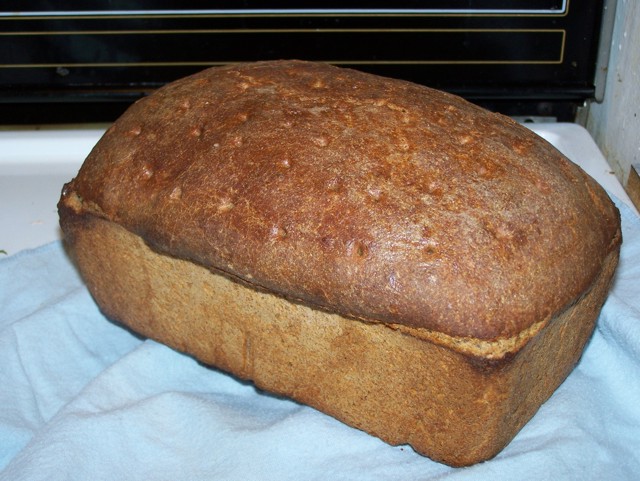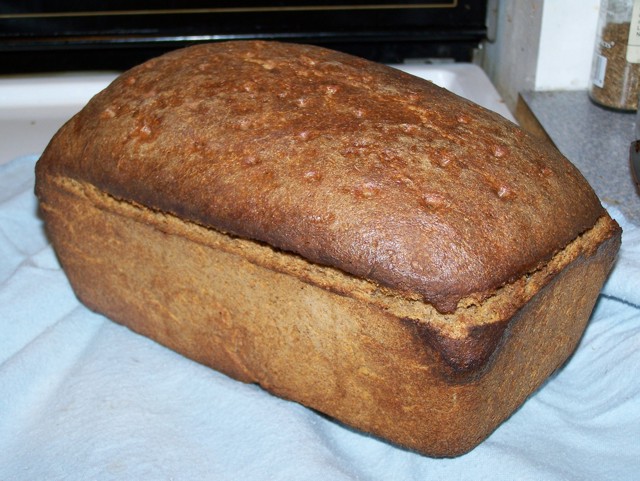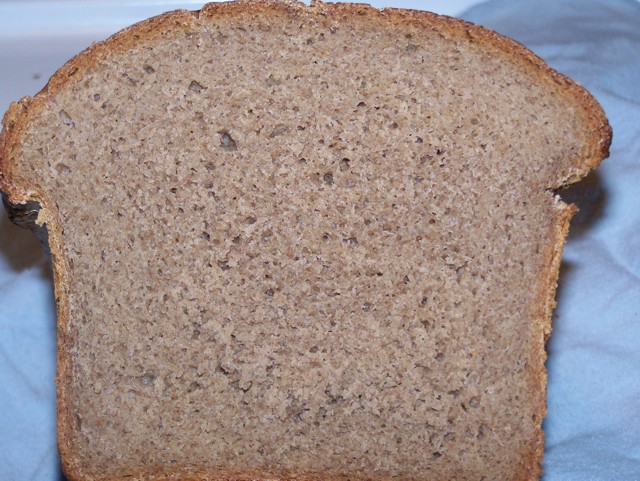
Hannoversches Doppelback photos
Well, I have baked this bread many times, but this time around a whole bunch of things were changed in the process. Number one was that I made my own starter more according to what I read here on this site, rather than what it states in my trusted W. Fahrenkamp "Knuspriges Brot aus dem eigenen Ofen"(Crispy/Crunchy bread from your own oven). I feel my new starter is way more active and the bread easily doubled in the 75 minutes bulk proofing time. I also decided to retard it overnight in the fridge-something I had never done before. Upon waking it had spilled out of the loaf pan and I folded it down, reshaped it and let it proof under a damp towel for another 30-45 minutes; by that time it had risen again quite a bit and I feared I would end up overproofing, so I stuck it into my preheated oven-tossed icecubes into the oven as I always do, plus a pan of water, but this time the bread was on the lowest shelf. Previously I would have trouble with the bottom of the loaf almost burning since it is baked at about 220celcius for an hour and then at about 280 celcius for another 10 minutes-so this was the first time of putting it on the lower shelf.
Since I am not in the habit of opening the oven during baking( can one open the oven?I would imagine for some breads letting the steam escape is not good) I didn't realize until 10 minutes prior to the 230 degree bake that the temperature somehow was only at about 190 degrees celcius-probably due to me pre-heating the oven at about 250degrees and then turning it down....anyways, I wonder if that is part of the reason why one side of the bread is cracked HMPH!It says in the book I took the recipe from that a crack in the crust can be cause by the oven temp being too low,too little steam, or over/underproofing-any thoughts? I also wrapped it in a towel to cool down afterwards, which I had never done before, but read about in this forum:for my personal taste I wouldn't do that again, since I love a super hard crust, but it actually makes the bread way way way more appealing to my husband!
Anyways, all in all the bread did not burn or get near to burning on the underside(yay!!!), the crumb is dense-without being very heavy, flavorful, moist, with just a very light sourdough taste(I hope it will taste more sour as the starter matures). I think overall I am happy with the retardation in the fridge, but then again it could also be the very vigorous SD culture I have now. If I can just ensure that the dear loaf doesn't get a crack in the crust the next time around...........
Below are some pictures-included the good and bad side of the loaf and crumb shot.

next the not so great side-I also don't know why the corner turned so dark*slightly grumbly*

lastly-crumbshot

I posted a recipe under my initial question about retarding this type of bread here:http://www.thefreshloaf.com/node/16558/question-about-retarding-german-sourdough-bread
Oh, I only kneaded this bread, in the bowl for about 10 minutes and added closer to 750 ml water-my starter was slightly lower in hydration than what the recipe called for and I generally do this by feel-it has to feel nice and velvety smooth and gooey.
I will have a nice thick piece of this bread with some Schmalz tonight.......I should have bought beer!
Christina


at least to me it does. Let us know how it tastes with schmaltz (is that butter or the Yiddish stuff?).
the yiddish stuff- Schmalz is rendered pigfat with cracklings..........terribly yummy! In moderation, of course! ;p
I thought schmaltz was rendered chicken fat.
Sorry that I was so unclear in my orginal post about the Schmalz-you bring up a valid point. The word "Schmalz" derives from "schmelzen"=to melt, so any rendered animal fat can be called Schmalz.I would say the most prevalent type of Schmalz in Germany is Pig-for the obvious reason of the size of the animal and the amount of fat it has- ; goose, duck and Butterschmalz are also common. If you were to order a "Brot mit Schmalz"(bread with Schmalz) in a Wirtshaus(rustic restaurant), you most likely would get rendered pig fat. Personally I find that pig or goose Schmalz are very excellent on german bread with some salt.....mmmm.
Christina
Christina, I agree. Altho Schmalz can be rendered from almost any meat source, it comes mostly from schweinefett or pig fat which has the best flavor.
Wow, That's a rye! Looks like you also found the magic hydration!
Here is an active link to the other thread: http://www.thefreshloaf.com/node/16558/question-about-retarding-german-sourdough-bread
About the crack. I think a combination of the wetness of the dough and the weight is falling over the edges of the pan. The heat sets the crust and the loaf keeps rising as the set crust floats causing the crack. Maybe you need a bigger pan or a smaller recipe or a slightly dryer dough.
As I am the last one to give up my moist rye bread, especially with a little cold schmaltz, paper thin sliced onion, salt and pepper, I would propose another solution. "Get us a Beer!" (sorry, all that schmaltz made me thursty!) I propose you make a round loaf, with or without a brot form but use a frying pan. A deep one with a nicely curved bottom and not too much width so if the loaf goes up, it just keeps going and no edge to get hung up on. Remove the handle so it fits into the oven. This works well for a wet Roggen Laib and gives a nice shape too.
Mini
Yeah, Mini, there was that flicker in my brain that said "duh, maybe a bigger pan or just bake the dough in two pans"-I have previously baked it in two pans-please do not ask why I did not heed my own wisdom, I would not be able to asnwer! ;p
Anyways, thanks for your comments both here and on the other thread- I definitely will try to do this rye without yeast-I love my current SD starter so much that I have absolute faith it will come out great.
Any tips, though, on substituting the yeast for more SD and proofing times( I was thinking, SD only maybe at least 8 hours at room temp and then stick it in the fridge?)
The rebaking might happen sooner than I anticipated, sicne my son has been only eating "Brot mit Marmelade" for the last few days.
Christina
I refresh my starter the night before and then mix up a straight shot with all the rye flour. My break through came when I started reducing the amount of starter in the dough. You are using a 50/50 flour mixture and it works for you, I think your starter is about right at 250g. The dough may take about 7-8 hours of total fermenting so shape when it is about 4 hours into the ferment and then watch it rise in the pan. When you think it is ready, dock and bake so your brot tiger can keep at it. Lucky boy!
If you want to retard it, try putting it shaped into the refrigerator after about only 4 hours. That's my suggestion for starters.
I've been sticking closer to 205°C (400°F) lately and just giving it more time in the oven.
When you run out of jam: http://www.tourmycountry.com/austria/erdaepfelkas.htm
Mini
Brot Tiger-das gefaellt mir! Ok, I will definitely follow your recommendations, since judging by your 100% rye results it would behoove me ;p Do you think retarding in the fridge is useful for this type of bread? Does it improve the sour flavor? At this point my current bread(only half of it is left-eaten by my tiger and me)has developed a deeper flavor the more it matures-one of those things I LOVE about that bread! I might have to have one more slice before I leave for work.... Christina
Mini-one more question: what is the reason you are baking at around 200 celcius and keep it longer in the oven , versus higher heat and shorter bake time? is there a difference in flavor, texture, crust?
i am trying the gerard rubaud miche recipe as posted by shiao-ping, and even though i know a dense,more german style loaf is way, way different from that miche, it just struck me how she says she heats the oven as high as possible and prefers the very hot/shorter bakes(if i recollect correctly-that is a long string of postings!)
and on another note-since you are in linz-what's your favorite recipe for Linzer Torte?
Christina
The simple answer is, I prefer to bake denser loaves as compared to open loaves. That doesn't mean baking at 200° results in dense loaf, it means that in order to bake the loaf until done, it needs a longer bake or it burns.
At the moment I have a smaller oven than the one in Linz. I find the smaller the oven, the faster the oven returns to temperature after opening the door. I've burnt the tops of too many loaves going 220°C and above with not enough top clearance between my loaf and the roof of my mini oven. ("mini oven dynamics") The light is unfortunately in the middle of the top and not suprisingly, adds to the problem. I start at 220°C to pre-heat (15 min) and introduce steam then drop it quickly to 210°C or 200°C. I've watched the temp and it keeps to around 200°C. With a denser crumb, the lower temperatures help the loaf bake through better without burning the outsides, it just takes longer. I should also add that it has a convection I can't turn off. (Each oven has its quirks) Most ovens need that little extra time to come back up to temperature. I do like crust color but don't want it too soon.
Shiao-Ping has a larger oven than myself, I'm sure of it. She is also trying to get fluffier loaves than myself. With more trapped air or CO2 pockets in the dough, higher heat can bake more efficiently.
I think it is fun how many variables there are to play with, when it comes to texture and crumb. Each person has their own goals, how they want their bread to be. Mine has to be strong enough to hold 2cm of Erdäpfelkas when sliced 8mm thick. My meat thermometer is a valuable tool for knowing when the loaf is done.
Take the pumpernikel, not much spring is really expected from this dense kind of loaf. It starts out high temp to set the outside crust quickly and then gradually reduced to low temps to finish the bake and carmelize the crumb. (Reminds me very much of quince jam and crock pots.) It can also be steamed for long periods of time. Or just baked at a low temp for a long time. Artisan doesn't mean always baked at high temperatures.
What doesn't work is a dense loaf baked in a very short time or an airy loaf baked too long no matter what the oven temperature.
Mini
I don't know how I missed this response of yours- thanks for the explanation! I am learning so much my head might burst!*wink*
Erdaepfelkas, Dampfnudeln, Kaiserschmarrn und die ECHTEN Mirabell Mozartkugeln rufen das furchtbarste Heimweh in mir hervor!
Am working on another german bread...........mayeb I will be daring enough to put it in a blog.Let's see!
Have fun in S. Korea with your mini oven!
Christina